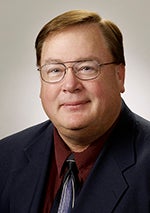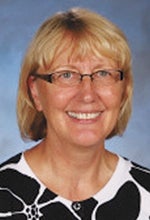New approach STEAMs ahead; Educators pleased with science, technology focus in I.J. Holton’s first year
Published 10:58 am Monday, June 9, 2014
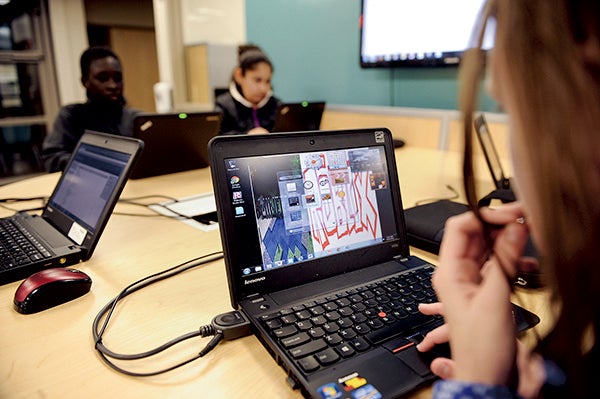
An I.J. Holton Intermediate School student utilizes the laptop she was issued at the beginning of the year. — Herald file photo
The first year of I.J. Holton Intermediate School’s STEAM approach has ended, and educators are pleased with the progress and all the positive response they’ve heard.
“I think overall the excitement and enthusiasm of the staff and community, parent and students, has been overwhelming,” Superintendent David Krenz said.
Holton opened Sept. 3, 2013, with a science, technology, education, fine arts and mathematics (STEAM) curriculum approach intended to teach students critical thinking skills.
I.J. Holton Principal Jean McDermott has also received a lot of positive feedback, and she was excited about how well the first year at the school went.
“The first year far exceeded my wildest dreams and what we could have expected,” McDermott said.
Krenz said more than three years of planning for the school generated a lot of excitement. He described the first year as rewarding. He was impressed by the hard work and effort put into the school and program by the staff through training, new approaches and technology.
Educators conducted surveys and compiled extensive information from both students and staff, which is part of the process to learn where the school stands, what has worked well and what needs to be changed.
“We wanted to make sure that as we did this, it wasn’t just a perception subject,” Krenz said. “We wanted to make sure we had objective data to really see what we’ve done and how it’s progressed.”
McDermott explained the school had 30 options to choose from for three-to-four week lesson units, and they chose engineering units. When the first unit went well, both teachers and students wanted to receive the second unit right away. McDermott said they are pretty intensive units that the teachers have to prepare for, but everyone embraced them so well that they wanted to get the second one going.
Although there were many things that went well, teachers realized there were a few things they had to change.
“There were also some lessons learned,” McDermott said.
Adapting to technology
McDermott was pleasantly surprised at how well students and teachers adapted to the new building and one-to-one laptops, among other changes.
“The laptops with students went especially well,” she said.
Students and teachers missed the convenience of Internet access during class discussions after students checked in their computers a week before school ended.
“Even for the four days without the computers, we didn’t realize how much we came to rely on them,” McDermott said. “It’s great to be able to pull it up and find the answers to continue conversation on a deeper level.”
Holton staff had anticipated students would know a lot about the new technology and how to work it, but since the students all had a different level of technology exposure, teachers had to slow down the training and back up a bit. McDermott said it changed the format for some lessons, but now that they know, they can fine-tune lessons to prevent further issues in the future.
Lesson plans have changed in other ways due to technology. McDermott said schools have always taught good manners, but now they teach good manners and courtesy while using computers, not only online but in the classroom too.
Teachers tried to teach students to self-monitor when it comes to computer use, McDermott said. If students know they will be distracted by having their laptop open on their desk, they need to learn to make the choice to close it. Having eye contact with the teacher and keeping hands off the keyboard is one of the rules that comes with having technology in the classes. While the tools might be different, this isn’t a new concept.
“[With] paper and pencil, we worked with passing notes. With the computer, it’s passing notes in a different way,” McDermott said. “It’s a different tool for kids to do what they always have.”
McDermott said there are also software programs in place to stop any inappropriate use of the computers, such as accessing inappropriate web sites. This software can also let teachers know if anyone tries to access blocked sites, and the school will then inform parents. Teachers try to get the students to understand being respectful and responsible with technology and just because they can do something, doesn’t mean they should.
While Internet access is convenient, the school now has to teach the difference between the sources students find, use and trust.
“Now they have to become discerning consumers of all that information,” McDermott said.
Learning in new spaces
The tools with the new school don’t stop with the new technology. McDermott pointed out how the furniture also helps create a good learning space. She said there are many flexible learning spaces in the building, as well as walls that are able to move to create or take away extra space.
“It took us a while feeling comfortable with how to use the furniture,” McDermott said.
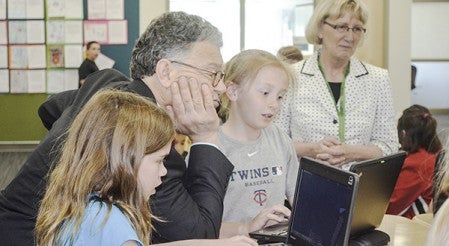
Catrina Herr shows Sen. Al Franken her power point for a “Cause and Effect” video that the students were working on. Franken visited I.J. Holton on Wednesday to look at the school’s STEAM curriculum approach. — Photos by Jenae Peterson/jenae.peterson@austindailyherald.com
The biggest challenges for students was the transition to the new building and learning how to use the new flexible learning areas. Yet they learned how to fully use the building and all it has to offer to make the most of it.
“We see a lot more collaborating going on,” McDermott said. “It just makes the whole way that we teach and learn look really, really different.”
It was a learning experience for teachers to find when it was helpful for students to work in small groups and when they should work alone. But even with no teacher directly supervising students working together, McDermott said she has been impressed with the students.
She remembers walking past a group of students and hearing them discuss a social studies project. One student gave a quote from President Barack Obama, but the other student replied the quote was already five years old and that they should find a new one.
“[The] conversations being had were awesome,” McDermott said. “We saw a lot of growth in the [FTLE area], flexible teaching and learning area.”
Krenz also spent time observing at Holton and he has been excited over how engaged the students have been.
“We’ve found over the years, it’s not what we’re teaching, even the difficulty or rigor of what’s being taught, it’s really the engagement of the students,” Krenz said.
Moving forward
McDermott said the school district will continue to evaluate student needs and how they change every year to keep giving students the best education possible. For now, laptops are working well with students in this age group. The devices handle most wear and tear that students put them through.
But McDermott said the fifth- and sixth-grade students were very responsible with the devices. She said out of 750 laptops distributed, only two were not returned and only about 15 needed substantial repairs.
“The kids for the most part really did a substantial job at being responsible with the equipment,” McDermott said.
She commended the students, parents and teachers for all trying their best to keep an eye on the devices.
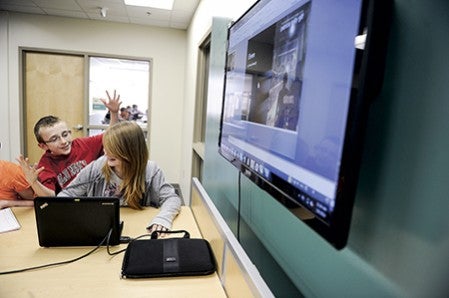
I.J. Holton student Noah Wollersheim, left, and Kaylee Shaw have some fun while talking about a project earlier this year. — Herald file photo
McDermott said staff have done surveys with the students, and there has been feedback with programs other than STEAM that the school has initiated, such as Peer Power Partners, and those have been positive. McDermott said parents have said their kids are being challenged more with the new programs, and that is a good thing. She said parents are excited that the classes are for everyone, and that they are able to have more opportunities to enhance learning.
As for the students, McDermott said they were happy to have laptops, the ability to collaborate with other students and not always be stuck at their desks.
Krenz said the way they teach is going to look differently with the new renovations they are doing at Ellis Middle School next year, and the one-to-one programs they are starting to implement.
Krenz said they are looking to implement the student engagement and the one-to-one technology aspects from I.J. Holton Intermediate School at Ellis Middle School, but it won’t necessarily be the STEAM approach.
“Each level [of learning] is different,” Krenz said.
Educators are looking to raise the level of science and math at both the middle and high school levels, but Krenz said it will look different because of the age group.


